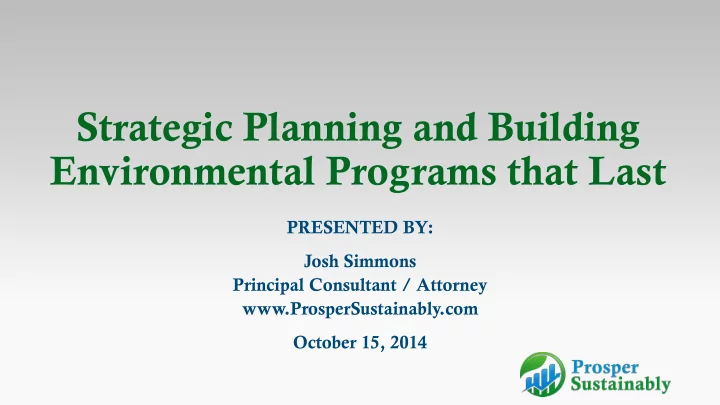

Strategic Planning and Building Environmental Programs that Last PRESENTED BY: Josh Simmons Principal Consultant / Attorney www.ProsperSustainably.com October 15, 2014
Strategic Planning and Building Environmental Programs that Last Please sign-in and provide contact information to receive a copy of the presentation, templates, other materials, and future notifications
Presentation Objectives Provide basic steps for how to develop strategic plans Describe considerations the strategic planning process Show how a strategic plan can be utilized as an TEP Share examples of tribal environmental strategic plans Provide templates for developing strategic plans Please sign-in to receive the presentation and templates
Strategic Planning Goals Develop effective, comprehensive plans that produced evolving, growing government services Create sustainable, indispensable environmental programs with diversified portfolios of support
Strategic Planning Process Understanding essential elements of lasting programs Gathering and reviewing info on issues/opportunities Scoping: defining the appropriate program area(s) Identifying and listing possible program objectives Understanding the essential, common threads of program success Preparing the initial strategic plan (could be an TEP) Maximizing the planning process by building key relationships Implementing and revising the strategy plan / TEP Regular review and revision is CRUCIAL
Essential Elements of Lasting Programs What do you think could be essential elements of lasting tribal environmental programs? Ongoing, sufficient funding Qualified, committed personnel Workforce development (jobs, internships, training, internal, external) Informed, supportive leadership Informed, supportive community members Tribal members, residents, employees, neighbors
Essential Elements of Lasting Programs What do you think could be essential elements of lasting tribal environmental programs? Mutually beneficial partnerships Continuous improvement / evolution A sense of purpose and meaning, passion Mission and Vision (can be captured in guiding statements or policies) Effective financial and administrative systems Strategies ensuring constant attention to these elements
Gathering & Reviewing Info Where and how do you think you can get information on important environmental issues and opportunities? Resource studies, management plans, assessments Surveys and interviews: community, stakeholders, etc. Input and feedback environmental staff Input and feedback from partners, leaders, etc. Prepare an Environmental Inventory (GAP) Applicable laws and regulations Grant proposals, work plans, progress reports
Gathering & Reviewing Info Steps for gathering and reviewing information: Best done by one person (for consistency) Maintain a summary research document Maintain a research log and folder Use to develop relationships & partnerships Example: Rincon TEP research
Defining Program Areas What may be your program areas? Indoor/Outdoor Air Quality Environmental Emergencies Solid & Hazardous Waste Land Use Planning & Devel. Water Resources Landscaping & Agriculture Wildlife & Habitat Education & Outreach Toxic Substances Marketing & Public Relations Energy Resources General / Admin / Financial Climate Change P2 / Greening Operations
Identify & List Objectives What are some area-specific, program objectives? Develop and implement a waste management plan Conduct an outdoor air quality assessment Host a youth environmental education event Install a solar photovoltaic system on the Tribal Hall Have staff complete 40-hr HAZWOPER training Prepare a wildlife & habitat protection ordinance Conduct ongoing surface water quality monitoring
Identify & List Objectives What objectives are common to many programs? Identify, pursue, and secure funding for… Hiring and training staff for managing… Develop and test education & outreach activities Conduct an initial study and establish a baseline Develop and implement a resource management plan Prepare a feasibility study for new or expanded initiatives Conduct ongoing monitoring and data analysis Develop and implement an evaluation plan Prepare and revise strategic plan
Identify & List Objectives Steps and considerations for listing objectives: Consolidate program areas as appropriate Objectives / Milestones = Capacity Indicators Refer to latest GAP guidance Copy and paste common objectives in each area Review objectives with key stakeholders Limit your review to their area of interest / overlap Be sure to capture all objectives and activities Include ongoing efforts and objectives Example: Objectives List Template
Prepare Strategic Plan How can you structure a plan to make it living, usable, adaptable, and not a dust-magnet? Don’t create a lengthy, printable document Keep it high level: only include major objectives Include ongoing major objectives; The plan must encompass all activities Prepare it in a table or in Microsoft Excel Include useful info such as responsibilities, work years Make it “sortable” by column (can use pivot tables) Create a perpetual 5-year strategic plan Remove and add a year every annual cycle 5 year maximum – longer is too uncertain
Prepare Strategic Plan How can you maximize the planning process? How can it be leveraged to increase ongoing program success? Frame the plan as a living document (always a draft) State that these are the initial ideas, subject to change based on feedback Review plans with leadership and supervisors in doses Solicit input and feedback (remind that this is just the initial draft) Focus on the upcoming year and unique objectives for future years Avoid restating repetitive goals (you can leave the document with them) Review each plan with key stakeholders Limit your review to their area of interest / overlap
Implement & Revise Strategic Plan What can you do with your strategic plan? Refer to it regularly to stay on track Use it to educate and involve others Increase awareness and understanding of environmental programs Create shared goals and objectives Develop key partnerships and collaborative efforts Identify and create links between efforts & initiatives Use it to prepare GAP work plan and other proposals
Implement & Revise Strategic Plan What should be the process for reviewing and revising the strategic plan? Review and update each area annually (AT MINIMUM) Minor updates can be continuous (give it a lot of attention in the 1 st yr) Important to do an annual, comprehensive review of each area o The review of each area can be staggered throughout the year Erase the prior year, add another year to the end Review/revise with staff, leaders, and key stakeholders Apply same guidelines from initial review (e.g. limit to areas of interest)
Thank You! Questions? jsimmons@prospersustainably.com (805) 694-8089 (office) / (805) 617-5685 (cell)
Recommend
More recommend